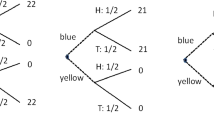Abstract
This is a contribution to the growing experimental literature on how trial-and-error adjustment processes can establish a convention for coordination on an equilibrium in a game. A simple bargaining game introduced by Nash is used for this purpose. Subjects are conditioned in different treatments to use four different bargaining solutions. The stability of the conditioning is then studied as the bargaining game is played over an extended period. The data obtained is unusually sharp. In the long run, the median subject behaves as though optimizing often down to a fraction of a penny. The results are therefore not supportive of the view that strategic considerations in such situations can be neglected in favor of a study of fairness norms. Indeed, the equilibrium actually achieved in a session turns out to be a very good predictor of what the median subject says is “fair” in the game after play is over.
Similar content being viewed by others
References
Binmore K, Dasgupta P (1987) The economics of bargaining. Basil Blackwell, Oxford
Binmore K, Morgan P, Shaked A, Sutton J (1991) Do people exploit their bargaining power: An experimental study. Games and Economic Behavior 3:295–322
Cooper J, DeJong D, Forsythe R, Ross T (1991) Selection criteria in coordination games: Some experimental results. American Economic Review 80:218–233
Gibbons J, Chakraborti S (1992) Nonparametric statistican inference. 3rd edition Marcel Dekker Inc. New York
Harsanyi J (1977) Rational behavior and bargaining equilibrium in games and social situations. Cambridge University Press, Cambridge
Isbell J (1960) A modification of Harsanyi's bargaining model. Bulletin of the American Mathematical Society 66:70–73
Kalai E (1977) Proportional solutions to bargaining situations: Interpersonal utility comparisons. Econometrica 45:1623–1630
Kalai E, Smorodinsky M (1975) Other solutions to Nash's bargaining problem. Econometrica 45:1623–1630
Myerson R (1977) Two-person bargaining and comparable utility. Econometrica 45:1631–1637
Nash J (1950) The bargaining problem. Econometrica 18:155–162
Peters H (1986) Bargaining game theory. PhD thesis, Proefschritt Universitat Nijmegen
Raiffa H (1953) Arbitration schemes for generalized two-person games. In: Kuhn H, Tucker A (editors) Contributions to the Theory of Games II, Princeton University Press, Princeton
Rao C (1973) Linear statistical inference and its applications. 2nd edition. Wiley, New York
Rawls J (1972) A theory of justice. Oxford University Press, Oxford
Roth A (1979) Axiomatic models of bargaining. Springer-Verlag, Berlin
Schelling T (1960) The strategy of conflict. Harvard University Press, Cambridge, Mass.
Van Huyck J, Battalio R, Beil R (1991) Strategic uncertainty, equilibrium selection principles and coordination failure. American Economic Reviews 80:234–238
Van Huyk J, Battalio R, Mathur S, Ortmann A, Van Huyck P (1991) On the origin of convention: Evidence from symmetric bargaining games. Working Paper, Economics Department, Texas A&M University
Author information
Authors and Affiliations
Additional information
We are grateful to the National Science Foundation for funding the experiments reported in this paper under Grant NSF-SES-8821521. We also gratefully acknowledge funding from the University of Michigan to set up the Michigan Economics Laboratory, where the experiments were conducted. We would also like to thank Richard Stallman and the Free Software Foundation for developing EMACS, Luke Tierney for developing LISPSTAT, and Hal Varian for showing us how to use both.
Rights and permissions
About this article
Cite this article
Binmore, K., Swierzbinski, J., Hsu, S. et al. Focal points and bargaining. Int J Game Theory 22, 381–409 (1993). https://doi.org/10.1007/BF01240133
Issue Date:
DOI: https://doi.org/10.1007/BF01240133




